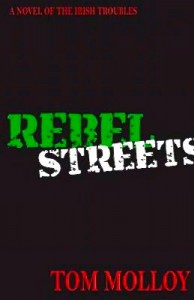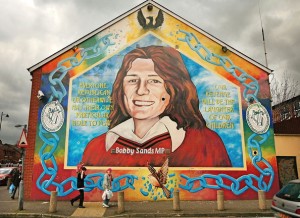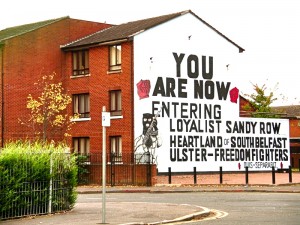“[In the Catholic Falls Road area], the IRA had shot out every streetlight, and the British army had painted walls black to hide their counter-ambush teams. Here was pure night, fog and fear, a place where Jack the Ripper could be expected in any doorway. Jack was long gone, but his heirs were about the streets, zipping by in cars without headlights, guns out windows…No one wanted to stray too far in Belfast these damp and cozy nights, none but the sons of Jack.”
 In this impressionistic novel about the on-going conflicts between Irish Loyalists and the Irish Republican Army and its militias in Belfast, author Tom Molloy’s dramatic scenes bring the full horrors of this long civil war to life, though for some partisans death is preferable to life as they have known it in their impoverished and violent neighborhoods. As the father of one Catholic from the Falls Road area of Belfast tells his son, “I am your father but they treat me like a child. I am a man and they will not acknowledge my manhood. See this, understand it, stand up to it when you can. This is our country. Often we can only fight them with our humor. Resist.”
In this impressionistic novel about the on-going conflicts between Irish Loyalists and the Irish Republican Army and its militias in Belfast, author Tom Molloy’s dramatic scenes bring the full horrors of this long civil war to life, though for some partisans death is preferable to life as they have known it in their impoverished and violent neighborhoods. As the father of one Catholic from the Falls Road area of Belfast tells his son, “I am your father but they treat me like a child. I am a man and they will not acknowledge my manhood. See this, understand it, stand up to it when you can. This is our country. Often we can only fight them with our humor. Resist.”
A former freelance journalist who accompanied the IRA during some of its bloodiest street battles, author Tom Molloy’s descriptions of Belfast and its battles bear the heavy truth of what he has seen and felt, and few readers will leave this novel without absorbing the full impact of the long enmity between those Catholics who still support turning the entire island into one Irish republic and those Protestants who believe that Northern Ireland should remain just as it is, part of the United Kingdom, supported by British troops. Those readers who believe that the Good Friday Accords of 1998, approved by voters from both parts of Ireland, effectively ended the hostilities which have torn apart the island for almost a hundred years, will be surprised to discover that bloodshed is still endemic to life in Belfast. As can  be seen in the YouTube video I have attached at the end of this review (recorded on October 3, 2012), some hard-liners from both sides still refuse to give an inch, despite the agreements made and accepted by both the IRA and most Loyalists fifteen years ago. Youthful gang violence and long-held resentments on both sides among under-educated and under-employed youth still explode into fires and fireworks, their personal frustrations fueling the long-lived undercurrent of resentment between the haves and have nots, and magnified by the long-held conflicts between Catholics and Protestants, and Irish vs. British.
be seen in the YouTube video I have attached at the end of this review (recorded on October 3, 2012), some hard-liners from both sides still refuse to give an inch, despite the agreements made and accepted by both the IRA and most Loyalists fifteen years ago. Youthful gang violence and long-held resentments on both sides among under-educated and under-employed youth still explode into fires and fireworks, their personal frustrations fueling the long-lived undercurrent of resentment between the haves and have nots, and magnified by the long-held conflicts between Catholics and Protestants, and Irish vs. British.
Though this novel depicts the era before the Good Friday Accords, it is as pertinent today as it would have been then. The novel feels like a play, its scenes sometimes self-contained. As the novel opens, Jimmy Fitzgerald, a Catholic, has been captured by the Ulster police and is being subjected to torture, as his interrogators try to break him. Being “handled” by Chief Detective Ian MacDonald, age thirty-seven, who appears to be kind during Jimmy’s interrogation, Jimmy finally breaks and agrees to inform on his fellow Catholics who still resist the local government.
 Depicting the lives of ordinary people trying to handle this level of conflict within their lives, author Molloy introduces numerous other characters – a sniper who kills a man at random, based on what he sees at night through a night-scope; a Viet Nam veteran who remembers watching a man being thrown out of a helicopter, his sandal left behind; an officer who sees through a “starscope” a group of “little green men” in Viet Nam, three of whom he kills; and a visitor to Ireland who discovers upon his return to Boston that integration in Boston and white flight are not all that different from what he is seeing in Belfast. Who this sniper is and whether he is one man or several is up to the reader to decide. Belfast, to this man, is “Tet without the Viet Cong.”
Depicting the lives of ordinary people trying to handle this level of conflict within their lives, author Molloy introduces numerous other characters – a sniper who kills a man at random, based on what he sees at night through a night-scope; a Viet Nam veteran who remembers watching a man being thrown out of a helicopter, his sandal left behind; an officer who sees through a “starscope” a group of “little green men” in Viet Nam, three of whom he kills; and a visitor to Ireland who discovers upon his return to Boston that integration in Boston and white flight are not all that different from what he is seeing in Belfast. Who this sniper is and whether he is one man or several is up to the reader to decide. Belfast, to this man, is “Tet without the Viet Cong.”
Main character Jimmy Fitzgerald eventually falls in love and sees life anew, and a woman, upon her torture by the British, loses her reticence and shyness to become a militant who stands up for herself and what she believes is right. The two “sides” become more human as characters Det. Ian MacDonald and Louis Duffy show their family lives – their wives and children and their genuine feeling for them. While Jimmy begins to look forward to a future with his love, the many political elements involved in Belfast life also become clear. The IRA and its offshoots, the British soldiers assigned to Belfast to  protect the local status quo, The SAS (the British Strategic Air Services), the Royal Ulster Constabulary, and various guerilla and paramilitary groups on both sides all complicate the issues of just who has the final word. On occasion, both sides are looking for the same person in order to discover just where that person’s loyalties really lie.
protect the local status quo, The SAS (the British Strategic Air Services), the Royal Ulster Constabulary, and various guerilla and paramilitary groups on both sides all complicate the issues of just who has the final word. On occasion, both sides are looking for the same person in order to discover just where that person’s loyalties really lie.
The characters, though thin, are well described within the circumstances in which they live, and their behavior is natural (assuming that the reader can identify with the extreme points of view which some of them have). Occasionally, the author tells the reader what s/he should believe – “A certainty came to [a woman]…that she was fully capable of real love,” instead of letting the reader discover this on his/her own – but that is more than compensated for by other insights. The action moves quickly from scene to scene, often without transitions, and keeps the reader engaged as points of view change back and forth among different characters. And when the sniper from Viet Nam returns to Boston and visits Fenway Park (a place near and dear to my heart), the imagery is particularly vivid: As the breeze from Fenway “blew into the fac es of the fielders, washed over the crowd in the bleachers and down to the streets of Boston, it pressed the city, brushing South Boston, its lace-curtained windows where shy red-headed girls dreamed of love, and touched their hardened brother on street corners….Then the air hit the chill Atlantic ….and on over the open waters to Ireland’s fields.”
es of the fielders, washed over the crowd in the bleachers and down to the streets of Boston, it pressed the city, brushing South Boston, its lace-curtained windows where shy red-headed girls dreamed of love, and touched their hardened brother on street corners….Then the air hit the chill Atlantic ….and on over the open waters to Ireland’s fields.”
The conclusion is not a surprise – the author has set it up from the outset – and it is expected. Its joy, if the ending can be considered joyful, is in its appropriateness within the thematic development. The novel is relatively short, and at times I wished that it had allowed for more development, especially with the ending, but overall, Rebel Streets successfully conveys the horrors of the civil war still being waged in Belfast.
Note: A YouTube video of recent Belfast rioting, from Sept. 4, 2012, shows how little things have changed:
Photos, in order: The author’s photo is from http://www.rebelstreetsthenovel.com.
The mural of Bobby Sands still overlooks Falls Road. Sands, an IRA Provisional, died in 1981 after a sixty-six day hunger strike in the prison known as The Maze. http://www.zimbio.com/pictures/lzY2V0yiNXX
This riot by Catholic militants took place in July, 2012, following a march by the Orange Order Brotherhood through their neighborhood. http://www.cathnewsusa.com
A Loyalist neighborhood, Sandy Row, is seen here: http://boldlygosolo.typepad.com
ARC: Nortia
